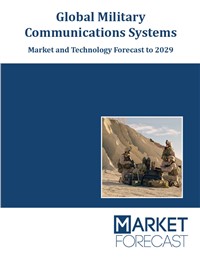In recent wars forces have used a variety of satellite applications, including remote sensing, communications systems, and GPS, to aid and support their military and intelligence gathering. As a result of technological issues as accessibility and security, the forces and their respective governments have continued to concentrate on both innovating their technology and developing new ways to use current military and civilian technologies, such as satellite applications, to facilitate and improve operations.
The Global Military Communications Market is evolving at a rapid pace. Moreover, ongoing military modernization programs in nations around the world, advancements in communication information technology, 5G integration, and integrated and interoperable BLOS communication capabilities is further expected to boost the growth of the market. Factors such as defense budget priorities, and integration of conventional platforms however, hinder the growth of the market to some extent. Interoperability, limited bandwidth and latency, and cybersecurity have created certain challenges for the global military communications market to grow.
The market revenue for Global Military Communications Market accounted for U$D 28.50 billion in the year 2020 and it is anticipated to reach a value of around U$D 39.72 billion by the year 2029. The market growth dynamics account for a CAGR of around 3.38% over the forecast period, 2020-2029.
North America is expected to dominate the Global Military Communications Market in 2029 with a market value of around U$D 11.3 billion owing to the ongoing military modernization programs in the nation. The rising global investments in the procurement of advanced tactical communications system to replace the old and conventional systems in the North America, Europe, and APAC region is another factor that is expected to fuel the growth of the Global Military Communications Market. Europe is expected to be the second-largest market with a value of around U$D 9.2 billion. North America is expected to be the fastest-growing market over the forecast period with a CAGR of around 3.73%.
The report is aimed at:
- The key drivers, restraints, and challenges which are expected to shape the Global Military Communications Market are covered in detail in the report.
- The key technologies which could have an impact on the Global Military Communications Market have been covered in detail.
- The top eighteen countries have been analyzed in detail concerning its spending by force, and % of total budget vs communication budget.
- The Porter’s Five Forces and the PEST Analysis of the Global Military Communications Market have been covered in the report.
- The high growth markets have been identified in the Opportunity Analysis Chapter.
- The market has been forecasted from 2020- 2029 considering all the factors, which are expected to impact the market.
- The Scenario Analysis Chapter covers the key scenarios and their impacts on the forecast chapter.
Segmentation covered in this report
The market is segmented based on Region, Equipment, Systems, and Force Type:
By Region
- North America
- Europe
- APAC
- Middle East
- ROW
By Equipment
- Communication Systems
- Radio
- Phones
- Multimode Radio Links
- Data Link Systems
- Others
By Systems
- Airborne Communication
- Air Ground Communication
- Underwater Communication
- Ground-based Communication
- Shipborne Communication
By Force Type
- Army/Land Force
- Air Force
- Navy
Country Analysis
- Argentina
- Belgium
- Bulgaria
- Finland
- Germany
- Italy
- Latvia
- Lithuania
- The Netherlands
- Poland
- Romania
- Spain
- Switzerland
- Ukraine
- Belarus
- Mexico
- Canada
- United States
Reasons to Buy
- The new players in the Global Military Communications Market and the potential entrants into this market can use this report to understand the key market trends that are expected to shape the market in the next few years.
- The Market Analysis Chapter covers the Key Drivers, Restraints, and Challenges of the Global Military Communications Market. The PEST and Porter’s five forces are covered in detail in this report.
- The key technologies that could impact the Global Military Communications Market have been covered in detail.
- The report can be used by the sales and marketing team to formulate their medium- and long-term strategies and to reconfirm their short-term plans.
- The report would help the sales and the marketing team to understand the key segments across the top eighteen countries which have been analyzed in the report.
- The Opportunity Analysis chapter identifies the key hot spots within the Global Military Communications Market.
- The company profiles include company overview, products & services offered by the company, recent news updates, and SWOT analysis for ten companies.
Who is this report for?
- Financial Institutions: Financial institutions such as financial intermediaries and banking institutions can use this report to assess their financing or investment strategies.
- Department of Defence: Defence department and other Governmental Organizations involved with the research and development of defense strategies using military communications can use this report to support their research.
- Department of Information Technology: The Department of Information Technology could use this report to understand various technical indicators of the top eighteen countries. This would give them an overall perspective of potential markets.
- Decision Makers: The future investment and technology focus decisions could be formulated based on the inputs of this report.
- Other Organizations: Various other NGO and Non- Governmental organizations involved with the research and development department for upcoming technologies can use this report to support their research.




